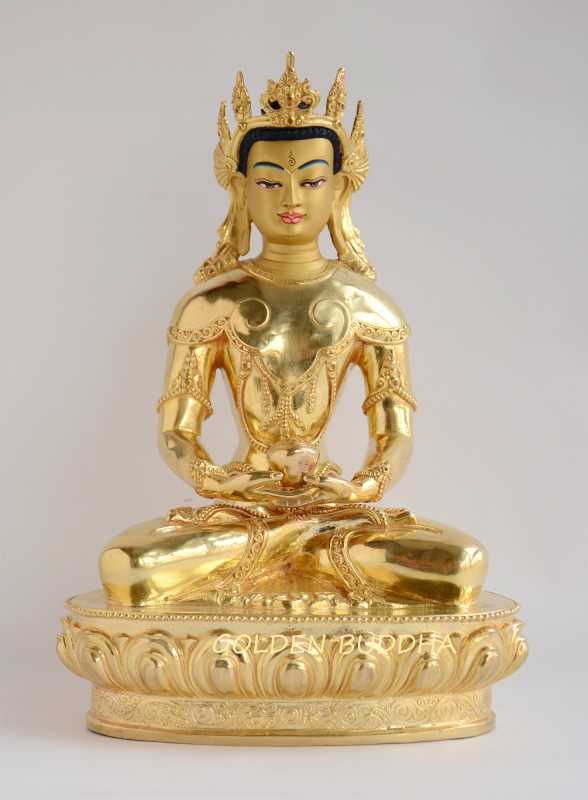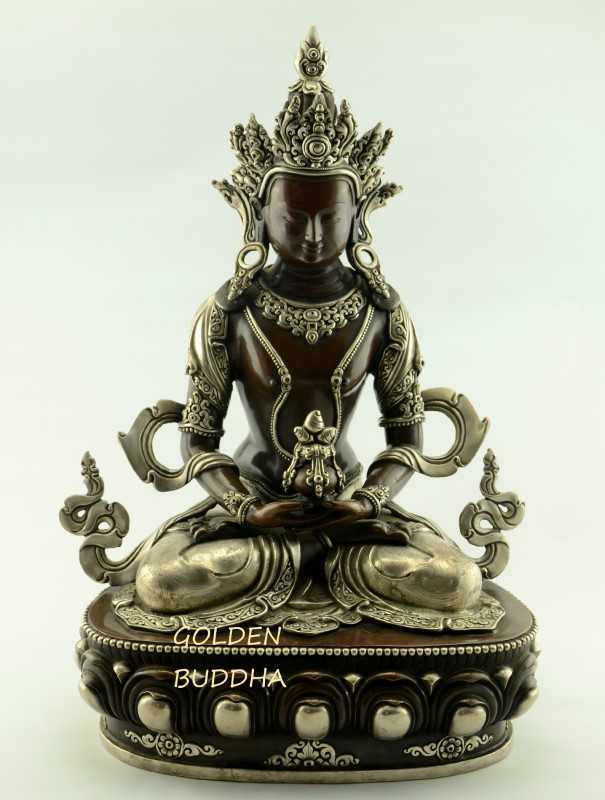Amitabha Buddha first appeared in the Mahayana Buddhist scriptures in the 1st century ACE. Specifically, the “Larger Sutra of Immeasurable Life” describes Amitabha and the Amitabha Pure Land. However, this does not mean that statues of Amitabha Buddha immediately appeared.
Indeed, evidence of the first Amitabha statues did not emerge until the 2nd century ACE. The belated appearance of the first Amitabha statues is not so surprising since Buddhist sculpture initially did not include depictions of the physical body.
But this changed when Buddhist art began to evolve in tandem with the rapidly growing popularity of Mahayana Buddhism. As a result, statues of the Buddhas and Bodhisattvas would become prominent features in temples and monasteries throughout Asia.
The establishment of Tibetan Buddhism would soon follow in the footsteps of Mahayana Buddhism. This led to the artisans of Nepal creating the best Amitabha statues for the Tibetan Monasteries beginning in the 10th century. Nepal has since become world renown for their sculpture and handicrafts.
List of Amitabha Buddha Links
- Popular Appeal of Amitabha Statues
- Amitabha’s Long Path to Becoming a Buddha
- The Amitabha Statues Meaning
- Longevity Attribute of Amitabha Statues
- The Pure Land of Amitabha Buddha “Sukhavati”
- How to use the Amitabha Mantra
- Buy Amitabha Statues Direct from Nepal
Nepali Amitabha Statue
Amitabha statues depict Amitabha sitting in full lotus pose in Dhyana mudra. Furthermore, Amitabha Buddha holds an alms bowl in the palm of the right hand and he is seated on a lotus pedestal.
Popular Appeal of Amitabha Statues
Mahayana Buddhism emerged several hundred years after the original Buddha entered Nirvana. Apparently, some of the Buddha’s disciples believed that the teachings of the original Buddha were not inclusive enough. As a result, a division emerged with some influential monks advocating a new approach called Mahayana.
Mahayana translates from Sanskrit as “great vehicle”. Indeed, the success of Mahayana would require the invocation of a strong central figure such as Amitabha Buddha. Indeed, the success of Mahayana rapidly gained in popularity with the help of Amitabha statues.
The Amitabha meaning is very reassuring and the Amitabha pure land of “Sukhavati” is very inclusive. As a result of this great vehicle, devotees can obtain the assistance of Amitabha Buddha and other bodhisattvas to relieve their suffering.
All they need to do is recite his name or the Amitabha mantra. Indeed, the effect Amitabha Buddha had on Buddhism is similar to the emergence of Jesus Christ in Christianity.
Amitabha’s Long Path to Becoming a Buddha
The Mahayana Buddhist texts describe the past lives of Amitabha as a Bodhisattva named Dharmakara. Dharmakara is a Sanskrit word which translates as “Treasury of Dharma” in English.
Indeed, Dharmakara served many, many lifetimes as a Bodhisattva that crossed over many eons and worlds. As a result, Amitabha accumulated an infinite amount of merit.
The path of Amitabha Buddha is in fact quite similar to the original Buddha – Shakyamuni. This is because Dharmakara was once a prince who renounced his kingdom and rejected the material world for a life of virtue and austerity.
The Amitabha Statues Meaning
Due to the infinite amounts of merit accumulated by Dharmakara, the Amitabha statues meaning became established as “Immeasurable Light and Life”. His name, Amitabha is a Sanskrit word that means “infinite light”. Furthermore, the longevity attribute of Amitabha is Amitayus which means “infinite life”.
The Amitabha meaning has a similar meaning in the Chinese language. In Chinese, Amitabha is “Amituofo” or “Emituofo“. “Amituo” is the transliteration of the Sanskrit word Amida, which means “boundless” and “fo” means Buddha in Chinese. When combined the Amitabha meaning would be “boundless Buddha” which is quite similar to “Buddha of infinite light and life”.
In Tibetan Buddhism, the Amitabha statue meaning is strongly associated with longevity. As a result, Amitabha appears as Amitayus (also known as Aparmita) which is the sambhogakaya embodiment of his longevity attribute. Additionally, in Tibet, he is also one of the three long life deities along with White Tara and Namgyalma.
Tibetan Buddhists also associate the Amitabha statue meaning with the color red. Indeed, meditation on the color red enables devotees to transform the poison of attachment into the wisdom of discernment. Amitabha Buddha is also one of the five Dhyani Buddhas.
Longevity Attribute of Amitabha Statues
In Tibetan Buddhism, the longevity attribute of Amitabha is integral to the Amitabha statue meaning. As a result, Amitabha statues (as Amitayus) are holding an “immortality vessel” filled with immortality nectar also known as “amrita”.
Amitayus Statue
Devotees participate in Amitabha longevity rituals in hopes of receiving long life from Amitabha. Long life is important and benefits devotees by allowing them to accrue large amounts of merit, similar to Amitabha.
In order for the longevity ritual to be effective, devotees insist that all of the participants have unfaltering belief in the Amitabha statue meaning and his longevity attribute.
In preparation for the ritual, a replica of his “immortality vase” is filled with consecrated wine. Additionally, devotees consume a small amount of the wine during the ritual with small pills made of dough. Devotees also recite the Amitabha mantra in hopes of obtaining longevity.
The Pure Land of Amitabha Buddha “Sukhavati”
The Bodhisattva Dharmakara was very devoted to relieving the suffering of sentient life. Therefore, he decided that a pure land of his own would be most effective to eliminate all suffering. After spending 5 eons and many lifetimes studying the pure lands of the Buddhas, based on what he had learned, he was able to intricately design his own pure land.
To create the Amitabha Pure Land, Amitabha fulfilled 48 vows. However, the eighteenth vow set the basis for the entrance of devotees. It required Amitabha to forgo becoming a Buddha until he could enable every devotee who recited his name or mantra (a minimum of 10 times) to gain entrance to the Amitabha Pure Land which he had named “Sukhavati”.
The pure land of “Sukhavati” now exists as a Western paradise. As a result, devotees who gain entrance to Sukhavati can obtain his divine assistance to progress on the Dharma path. Once admitted to Sukhavati, devotees will never fall back into samsara on account of his protection and guidance.
Sukhavati is indeed a land of sonorous and visual bliss and all are welcome there who say Amitabha’s name or recite the Amitabha mantra at least 10 times. Since his 48 vows were fulfilled, Amitabha became a Buddha and he is the infinite ruler of his Western Pure Land.
How to use the Amitabha Mantra
There are several acceptable versions of the Amitabha mantra. In Sanskrit, there are two variations “Om Amitabha Hrih” and also “Namo Amitabha Buddha”. In addition, the Amitabha mantra meaning is “Homage to the Amitabha Buddha”.
However, in Vajrayana Buddhism they use the Tibetan pronunciation which is “Om Ami Dewa Hri”. Furthermore, in China, their version of the Amitabha mantra is simply his name in Chinese – “Amituofo”.
The objective of using the Amitabha mantra is to induce sufficient concentration in order for devotees to gain access to Sukhavati. The minimal requirement is to simply to “recite his name or his mantra” at least 10 times in a row.
It is not important which version of the Amitabha mantra devotees choose to use. Indeed, the only requirement is that devotees must have unwavering sincerity, faith and aspiration to be reborn in Sukhavati. If so, chant the Amitabha mantra a minimum of 10 times:
“Om Amitabha Hrih”
Buy the Best Amitabha Statues Direct from Nepal
Discover the world’s best handcrafted Amitabha statues in Patan, Nepal. My local partners and I have been working with the Nepali artisans for over 3 generations. Rest assured that when you buy a gold gilded Amitabha statue from Golden Buddha you will receive a monastic quality statue direct from the artisan who created it.
Each statue is a handmade original with no other like it in the world. It will also be of the same high quality that is found in the Tibetan monasteries.
In addition, each statue is handmade in intricate detail using traditional methods. After the statue emerges from the fire, it is then gold gilded with 24k pure gold. The final step is face painting using real gold and imbuing the statue with lifelike qualities. All statues are 100% authentic and come with the certificate of authenticity from the Department of Archaeology in Kathmandu.
The golden luster of an authentic gold gilded statue will remain free of tarnish and display the infinite glow of the Amitabha Buddha meaning. When you see the statue in person it far exceeds what is seen in photos. All who lay eyes on the statue will be inspired.




